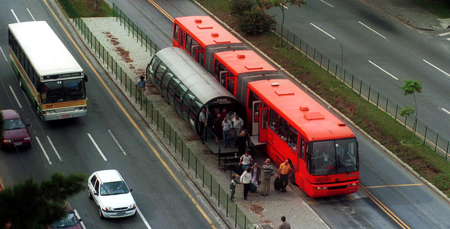At vivaNext, we’re working hard to build a Bus Rapid Transit [BRT] system. And we’re not alone! Our vision of fast, reliable and convenient BRT service is shared by many cities and regions, all over the world.
Bus Rapid Transit is a global phenomenon that has nearly quadrupled over the last 10 years, growing 383% worldwide from 2004 to 2014, according to data compiled by the Institute for Transportation and Development Policy.
buses! buses!
Former mayor of Bogotá, Colombia, Enrique Peñalosa, said it best with his rally cry: “Buses! Buses! Buses! Buses!” That was his response to a suggestion that some municipalities might benefit from a subway.
Indeed, for many cities and regions, BRT simply makes sense. A BRT system can be built at a fraction of the cost and time of a rail system – in the span of a few years instead of a decade or more – and still provide service that can be just as reliable, fast and frequent as a train.
More cities and regions are turning to BRT as their transportation solution, with 1,849 kilometres of new lines added globally in the last decade. In York Region, our contribution was the six- kilometre stretch of rapidway on Highway 7 East! And that’s just the beginning.
32 million global BRT riders every day
Around the world, 32 million people ride BRT every day, according to the global database BRTData.org. That’s 5,087 kilometres of BRT lines in 193 cities.
The undisputed global leader of the movement is Latin America with nearly 20 million passengers, followed by Asia with 8.7 million. Brazil is the birthplace of BRT, and the country with the largest network of systems; nearly 12 million passengers a day in 34 cities!
Bus Rapid Transit grew the most in China with construction of 552 new kilometres over the last decade, followed by Brazil with 345 kilometres, and Mexico with 234 kilometres, according to the Institute for Transportation and Development Policy.
Closer to home in North America, BRT is a small but growing phenomenon with one million passengers in 27 cities. The United States was fourth worldwide in terms of growth, with 104 kilometres of new lanes built in the last 10 years.
9.6 million annual riders on Highway 7 East rapidway
Here in York Region, we’re working hard to bring the vivaNext vision to life. Our current plan will include 34 kilometres of rapidway once construction is complete, connecting the communities of Markham, Vaughan, Richmond Hill and Newmarket. That includes the six kilometres already running in Markham. We’re also forging connections with the Spadina Subway Extension, and advancing plans for the Yonge North Subway Extension. In 2014, our Highway 7 East rapidway in Markham had 9.6 million riders, so we’re well on our way.
We’re building rapidways but the true end product is something much greater – mobility. Mobility makes everything possible. Because BRT runs in designated lanes it’s not subject to the whims of traffic. When our rapidways are complete, people will know they can rely on Viva service to get where they need to go – to work, to school, and to life. As our communities grow and roads get more congested, our rapidway system will be ready to meet the growing demands of our region – part of a global movement moving people forward into the future


